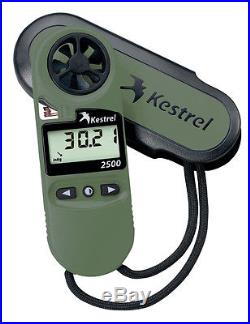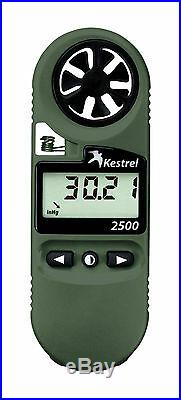



Kestrel 2500NV Pocket Weather Meter (Anemometer) Features Include: Current Wind Speed, Maximum Wind Gust, Average Wind Speed, Air, Water & Snow Temperature, Wind Chill, Barometric Pressure & Altitude w/ Night Vision! We are an Authorized NK Kestrel Dealer! Our price for this product is the lowest NK allows it’s dealers to sell it for. Anyone claiming to be a dealer who advertises this item or accepts best offers lower than our price is most likely not a Kestrel dealer. Assembled in the USA! The Kestrel 2500NV takes the great features of the Kestrel 2000 and adds in a pressure sensor. A three-hour pressure trend indicator helps you predict fish and wildlife activity and know when the weather’s going to turn nasty. With its easy-to-use digital pressure altimeter, you have the perfect instrument for any outdoor activity. In addition to predicting weather activity, barometric pressure also influences a bullets trajectory, which is why the Kestrel 2500 is used by shooters and hunters when accuracy is important. US Olympic Rifle Champion Shooter Lones Wigger wouldnt trust any other instrument. The Kestrel Meter is essential for target rifle shooting. It helps me win matches, and I rely on it for accurate weather information. This model includes NV Configuration. Military personnel and pilots flying in darkness are often concerned with preserving their night vision. Due to overwhelming demand from our military customers, the Kestrel NV line was added in 2005. Note: The Kestrel 2500NV has a night-vision preserving backlight which helps users to sustain natural night vision. The NV’s backlight incorporates an optical filter to reduce overall brightness and minimize blue and green spectrum light to preserve night vision. Additionally, NV backlights are also much dimmer than a standard backlight, making it more difficult to detect with the naked eye in night operations. This backlight appears soft greyish pink, not red, and is still in the visible spectrum, so is not compatible with night-vision equipment. It takes 30 to 45 minutes for the average eye to adapt to darkness and maximize night vision. Even a short burst of white, yellow, green or blue light bleaches out the rod cell photoreceptors in the eye and causes night blindness until the entire adaptation process can take place again. Light in the red spectrum does not cause this bleaching out, preventing night blindness and night vision fatigue. Certified and Guaranteed Accuracy Every single Kestrel manufactured at Nielsen-Kellerman is calibrated for every single value, either directly against NIST-traceable standards or against an intermediary standard that is calibrated daily. What does that mean for the customer? They can be absolutely sure that their weather readings are accurate to the stated specifications. Some competing weather instruments claim the same specifications as Kestrel, but only Kestrel certifies their accuracy. A slip-on protective cover. CR2032 coin cell battery (Average life 300 hours). Kestrel Certificate of Conformity. Protective cover with sure-grip overmolding. Large easy-to-read display with backlight. Innovative design for stability and accuracy in abrupt condition changes. Quick response, external thermistor. High precision pressure sensor. Reliable, portable and easy to use. All instruments and accessories are completely assembled in the USA. Wind Speed 1 second. 0.4 to 60.0 m/s. Larger of 3% of reading or least significant digit. 0.4 to 40.0 m/s. 59 to 11,948 ft/min. 59 to 7877 ft/min. 1.0 to 218.0 km/h. 1.0 to 144.0 km/h. 0.8 to 135.0 mph. 0.8 to 89.0 mph. 0.6 to 118.3 kt. 0.6 to 78.0 kt. 0 to 12 B. 1 inch diameter impeller with precision axle and sapphire bearings. Calibration drift < 1% after 100 hours use at 16 MPH / 7 m/s. Sustained operation above 60 MPH / 27 m/s will wear impeller rapidly and may cause destruction of impeller. Replacement impeller (NK PN-0801) may be field-installed without tools (US Patent 5,783,753). 49.0 to 257.0 °F. 20.0 to 158.0 °F. 45.0 to 125.0 °C. 29.0 to 70.0 °C. Measures air, water and snow temperature. Thermally isolated, hermetically sealed, precision thermistor mounted externally (US Patent 5,939,645). Pressure 1 second (mb & PSI 4000 model only). 0.3 to 32.5 inHg. At 77.0 °F, 22.1 to 32.5 inHg. 10.0 to 1100.0 hPa / mb. 1.5 hPa / mb. At 25.0 °C, 750 to 1100 hPa / mb. 0.15 to 16.0 PSI. At 77.0 °F, 10.9 to 16.0 PSI. Monolithic silicon piezoresistive pressure sensor with second-order temperature correction. Maximum error over temperature range 32 to 158 °F (0 to 70°C) , +/- 0.06 inHg / +/-2.0 hPa. Calibration drift typically -0.03 inHg / -1.0 hPa per year. Pressure sensor may be recalibrated at factory or in field. 6000 to 30000 ft. At 77.0 °F, <19,700 ft. Max error +/- 98 ft. 2000 to 9000 m. At 25.0 °C, <6,000 m. Max error +/- 30 m. Temperature compensated pressure (barometric) altimeter. Wind Chill 1 second. 0.7 to 135.0 MPH, -49.0 to 257.0 °F. 1.8 to 89.0 mph, -50.0 to 50.0 °F. 0.4 to 60.0 m/s, -45.0 to 125.0 °C. 0.4 to 40 m/s, -45.6 to 10.0 °C. Calculated from the primary measurements of wind speed and temperature. Utilizes the NWS Wind Chill Temperature (WCT) Index, revised 2001, with wind speed adjusted by a factor of 1.5 to yield equivalent results to wind speed measured at 10 m above ground. Specification temperature limits established by WCT Tables. One-button clear and restart of Max Wind Gust and Average Wind measurement. Continuously updating three-hour barometric pressure trend indicator: rising rapidly, rising, steady, falling, falling rapidly. Reflective 4 digit LCD. Digit height 0.36 in / 9 mm. Includes a optical filter to reduce overall brightness and minimize blue and green spectrum light to preserve night vision. The NV backlight appears soft greyish pink. Real-time hours:minutes clock. Operational Temperature Range (LCD and Batteries). The operational temperature range of the liquid crystal display and batteries is 14° F to 131° F / -10 °C to 55 °C. Beyond the limits of the operational temperature range, the unit must be maintained within range and exposed for minimum time necessary to take reading. 22 °F to 140 °F / -30 °C to 60 °C. After 45 minutes of no key presses. Individually tested to NIST-traceable standards (written certificate of tests available at additional charge). Average life, 300 hours of use, +/-depending on backlight use. Substantial impact may damage replaceable impeller. Unit 4.8 x 1.7 x 0.7 in / 122 x 42 x 18 mm. Case 4.8 x 1.9 x 1.1 in / 122 x 48 x 28 mm. Unit 2.3 oz / 65 g. Case 1.3 oz / 37 g. Kestrel Meters are designed and manufactured at NKs facility in Boothwyn, Pennsylvania, and are individually calibrated at the time of manufacture. Every Kestrel Meter comes with a Certificate of Conformity to document the units accuracyall Kestrel measurements are traceable to the National Institute of Standards and Technology, ensuring the highest level of reliability. Additional NIST Calibration and Certification services are available. This is one of the many reasons we remain popular with our customers. Doing that is against U. Thank You for your interest! The item "Kestrel 2500NV 2500 Pocket Weather Meter with Night Vision Preserving Backlight" is in sale since Monday, September 27, 2010. This item is in the category "Home & Garden\Yard, Garden & Outdoor Living\Garden Décor\Weather Stations". The seller is "weatherrepublicllc" and is located in Coatesville, Pennsylvania. This item can be shipped worldwide.
- Model: 2500NV
- Country of Manufacture: United States
- Indoor-Outdoor Use: Indoor/Outdoor
- Country/Region of Manufacture: United States
- Measurements: Wind Chill
- Type: Meters, Stations
- MPN: 0825NV
- Brand: Kestrel


